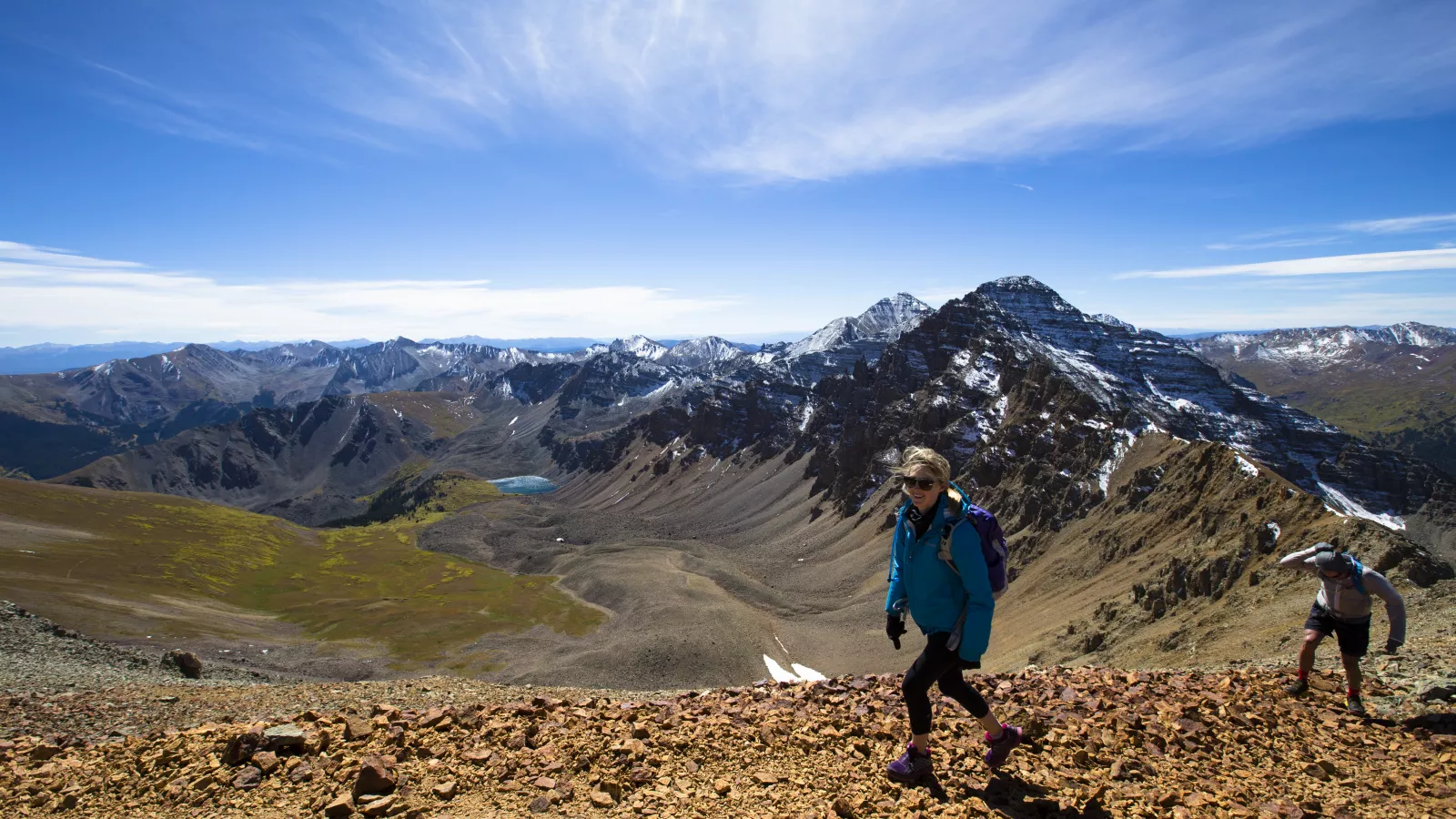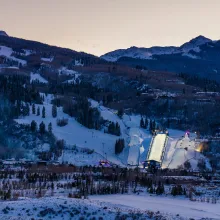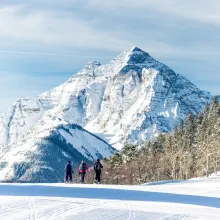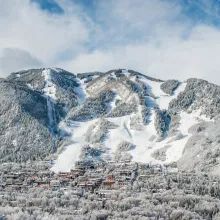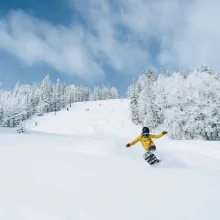There are few activities in life as simple and rewarding as summiting a mountain. Whether a leisurely hike, half-day trail run or technical alpine climb, ultimately, it’s about getting to the top and taking in the view. But not all mountains are equal, and “14ers”— peaks topping 14,000 feet in elevation—are held in high regard. Colorado boasts 58 of these prestigious peaks, or more than 80 percent of the 14ers in the contiguous United States.
*This guest blog comes from Tess Weaver, a local writer and editor based in Aspen. Follow her adventures on social @TessWStrokes
“To climb a 14er is to experience all CO has to offer,” says Aspen’s Darcy Conover, Corbeaux founder and a skier and mountaineer who has climbed or skied all of the state’s 14ers and 94 of the Colorado’s 100 highest peaks . “You might start in a dark, dense coniferous forest, then make your way through a quaking Aspen grove that opens up the alpine tundra cut by a burbling alpine stream blanketed in wildflowers. Climb on to reveal a talus field to the summit where the views of the peaks surrounding you for miles are unmatched.”
Aspen is home to eight 14ers: North Maroon Peak, Maroon Peak, Pyramid, Capitol, Castle, Conundrum and Snowmass in the Elk Mountain Range, and La Plata, located just over Independence Pass. They all offer variety in terms of aesthetics and level of difficulty.
Mountaineering routes are graded by difficulty, Class 1 (easy on-trail hiking) to Class 5 (technical rock climbing that involves ropes). Class 2 includes a wide range of hiking and a route may have exposure, loose rock and steep scree, while Class 3 requires crambling or un-roped climbing. Aspen’s Class 4 routes cover steep and dangerous terrain and require handholds and footholds for upward or downward movement.
Due to its proximity to Aspen (technically the closest 14er to downtown Aspen and the peak most visible driving up valley on Highway 82), interesting and challenging terrain, spectacular views and resident summit mountain goats, Pyramid Peak is a local’s favorite and a classic first technical 14er. While ropes aren’t necessary on standard northeast ridge, the route requires excellent alpine navigation and class 3 scrambling skills.
“Route finding on the Elks 14ers can be quite difficult,” says Nate Rowland of former Aspen Alpine Guides. “Going off route puts you in even more hazardous terrain with steep loose slopes. Hiring a guide can alleviate the stress of route finding and allow you to be more present in the moment, enjoying the climb, scenery and challenge of our local peaks.”
Aspen Expeditions offer guided climbing on local 14ers.
Local’s Tips:
Build up to it. Don’t tackle a 14er the first day you get to Aspen; practice exercising and sleeping at altitude.
Do your research. Know the route and keep an eye on the weather.
Pack appropriately. No matter how blue the sky looks when you wake up, bring an extra layer and a high-quality shell.
The rock in the Elks is notoriously loose. For most peaks, wear a helmet.
Get an early start. It always takes longer than you think. Allow time to find your way and enjoy the summit.
Eat a solid breakfast and snack frequently (many experts say every hour).
Know that the day will probably bring highs and lows. Embrace them.
Never climb above another climber and stick to the main routes where the rubble has been cleared.
Take it all in, but remain mentally alert.
Minimize damage to the fragile high-alpine ecosystem. Learn the Care for Colorado Principles, which provide tips on how to care for our 14ers.
Aspen's 14ers
1. North Maroon Peak - 14,014 feet
Rating: Class 4
Vertical: 4,450 ft
Standard route length: 8 miles round-trip
The semitechnical Northeast Ridge route is steep, loose, exposed and has a Class 4 (climbing) section where many guides rope up their clients.
2. Maroon Peak - 14,156 feet
Rating: Class 3
Vertical: 4,600 ft
Standard route length: 10 miles round-trip
The Class 3 (scrambling or unroped climbing) South Ridge Route is a strenuous exercise in navigation and determination. The traverse between North and South Maroon is one of the great classic 14er traverses.
3. Pyramid Peak - 14,018 feet
Rating: Class 4
Vertical: 4,450 ft
Standard route length: 6 miles round-trip
Steep slopes, loose rock, exposed ledges and the occasional Class 4 move puts Pyramid on the border of the “technical” peak category.
4. Capitol Peak - 14,130 feet
Rating: Class 4
Vertical: 5,800 ft
Standard Route Length: 17 miles round-trip
Often considered the most challenging 14er in Colorado thanks to a spectacular knife-edge ridge, Capitol (also a Class 4 climb) is often done as an overnight mountaineering experience, camping at scenic Capitol Lake.
5. Snowmass Peak - 14,092 feet
Rating: Class 3
Vertical: 5,100 ft
Standard route length: 21 miles round-trip
With one of the most scenic approaches, Snowmass Peak, a Class 3 mostly done as an overnighter, is unique in offering a near year-round alpine snow-climb ascent.
6. Castle Peak - 14,265 feet
Rating: Class 2
Standard route length: Up to 10 miles round-trip
Vertical: 4,500 ftCastle Peak is the highest 14er in the Elk Range, but with a Class 2 rating, it’s an ideal beginner 14er that still offers an exciting summit ridge with sprawling views.
7. Conundrum Peak - 14,060 feet
Rating: Class 2+
Vertical: 4,300 ft
Standard route length: Up to 10 miles round-trip
Long considered a sub-peak of Castle Peak, (it rises less than 300 feet from its connecting saddle with Castle), Conundrum was added to the Colorado Geological Survey’s official 14er list in 2008 and makes for an approachable double 14er day.
8. La Plata Peak - 14,336 feet
Rating: Class 2
Vertical: 3,380 feet
Standard route length: 7 miles round-trip
Located just over Independence Pass in the Sawatch Mountain Range, La Plata is the fifth-highest peak in Colorado and offers a relatively easy Class 2 climb with some difficult hiking that may be off-trail.
Tag us on social @AspenCo on your 14er adventure.
Not trecking a 14er this year? Check out these local hikes in Aspen in the video below!

